Le is the capital of fog, Le is also the capital of Jiangdu, Qiaodu, accompanying capital, and mountain city. One article will take you around Chongqing
All photos in the article were taken by the author of "Touch of Black and White". All rights reserved. Misappropriation without permission is strictly prohibited!
Recommended reading: (Battle between Chengdu and Chongqing)
Impression of Chengdu: shī, shī
Jianghu"Soft China, hard Yuxi, the shorter the hair, the more cowhide it is; seizing territory and pinching fur, no matter how big the occasion is, you must not be arrogant."
These are two lyrics written by rapper GAI, who has become popular in recent years, in his work "Soul of Chongqing".
GAI was born in Sichuan, but his rap career flourished in Chongqing. Perhaps Chongqing has a temperament that suits his character, and the suitable soil breeds unique creations:
"I am walking across the street. If you want to fuck me, please raise your hand. I know that you are angry and angry, but you don't dare to fuck me. Then you deserve it."
"When I raise my hand, I can touch the sky and see the white clouds and green mountains and the curling smoke. Although I have no bank to turn back for pleasure in the sea of suffering, I walk between heaven and earth gracefully."
"I can't learn to bend down. Each mountain is higher than the next."
"How can dust hide the beauty? The vast yellow and yellow are bathed in the gray clouds. Five thousand years are like quicksand. It is not a waste of my soul entering China."
......
(The picture below is from the Internet)

This is a kind of frank and straightforward character. There is the arrogance and rebellion of a small person, the lofty pride of the world, the happy gratitude and hatred of revenge, and the freedom and freedom of victory and defeat in the sky.
What breeds this "gang style" is Chongqing's Jianghu spirit.
Chongqing is a dock city on the upper reaches of the Yangtze River. It is located at the intersection of the Yangtze River and the Jialing River. It is the gateway to Sichuan. It has a dangerous terrain and has been a military important place since ancient times. During the Song Dynasty, shipping along the Yangtze River was prosperous, commerce along the route flourished, and the important military town gradually became a prosperous commercial capital. A large number of goods gathered at the docks here. Merchants, tourists, boatmen, porters... Three religions and nine streams gathered here. For survival and interests, dazzling tricks and tricks emerged one after another, and peddles and soldiers were in full swing...
Wherever there are people, there are Jianghu. Even Chongqing's specialties are called "Jianghu Cuisine", reflecting the popularity and complexity of Chongqing's Jianghu.
(Jiugongge Hot Pot was originally designed to make it easier for people with different tastes to eat together)

However, just as GAI's "gangs" are not limited to the grievances of "gangs and gangs", Chongqing's Jianghu is not just about the cunning of three religions and nine streams. Chongqing, taken apart and written, means "thousands of miles" and "vast". Today's article will take you to visit Chongqing and appreciate the "thousands of miles and reach the vast" of this famous city in the southwest.
(Chongqing Grand Theater)

ciqikou
Let us start our journey to Chongqing with the ancient town of Ciqikou, a famous historical and cultural street and one of the twelve scenic spots in Bayu.
The ancient town of Ciqikou was built in the Northern Song Dynasty. It was originally called "Baiya Town" because it backs Ma 'anshan, and there are white stone walls on Ma' anshan. During the Ming Dynasty, Emperor Jianwen Zhu Yunwen was forced to abdicate by King Zhu Di of Yan and moved here to live in seclusion, so it was also called "Longyin Town". In the Qing Dynasty, the ancient town began to make and sell porcelain. Merchants gathered, trade was smooth, and it flourished for a time. At that time, it was said that "thousands of people hand over each other in the day, and tens of thousands of bright lights come at night," so it was named "Ciqikou".

The ancient town is located in the northeast of Shapingba District, Chongqing, facing the Jialing River and backed by Geleshan. It is surrounded by Qingshui River and Fenghuang River. The three mountains of Jinbi Mountain, Ma 'anshan and Fenghuang Mountain are juxtaposed. It has a beautiful environment and rich people. Ciqikou is the birthplace of Shaci culture. During the Anti-Japanese War, the National Government moved the capital to Chongqing. Ciqikou's commercial trade and cultural activities were unprecedentedly prosperous. Many celebrities such as Zhou Enlai, Xu Beihong, Ma Yinchu and Ding Zhaozhong once stayed here. Their activities advocate patriotism, attach importance to education, and pursue national justice. It is a banner of culture in the rear area of the Anti-Japanese War.
Today's ancient town of Ciqikou, in addition to Shaci culture, also has its own distinctive Bayu culture, Hongyan culture and religious culture. You can enjoy the changing faces of Sichuan opera here, understand the extraordinary years of the Anti-Japanese War, and experience the heroic style of "Red Rock"., or sip tea in a riverside teahouse and enjoy the river scenery.

There is a Xinji grocery store on the south side of Ciqikou Main Street. It does not sell groceries here. It is an exhibition hall that displays the "Red Rock Spirit". Xinji Grocery Store was the main window for revolutionaries detained by Kuomintang military agents in Jazidong to exchange information with the outside world. It was also one of the important secret contact points of the underground party of the Communist Party of China at that time. Han Zidong, the prototype of Hua Ziliang in the novel "Red Rock", once conveyed a lot of precious information here.

Walking along the main street from the grocery store, we arrived at Baoshan Palace. This was originally a Taoist temple. During the Anti-Japanese War, it was the site of Jialingjiang Primary School, and physicist Mr. Ding Zhaozhong studied here. The environment in the park is elegant and contrasts sharply with the noise of the streets. Today, Baoshan Palace is a tea house and Sichuan opera performance venue.

The transfer building in the middle of the main street is very conspicuous, and the visitors are wearing makeup and costumes, and are very enthusiastic.

The transfer building is a unique teahouse hall in the ancient town of Ciqikou. You can enjoy performances such as pijin rolling lanterns, Sichuan opera face-changing, traditional tricks, and folk music performances while drinking tea. There is also a legendary deep well here. It is said that when Emperor Jianwen wandered to the mouth of the magnet, he was extremely hungry and hungry. He had to avoid inspections at passing checkpoints. He panicked and plunged into the dry well. Just as he lamented his bad luck and was about to close his eyes and wait for death, a clear spring suddenly gushed out from the bottom of the well. Since then, many dry wells at the mouth of Ciqikou have flowed with sweet and delicious clear springs, so the common people also called this well a "raw water well."
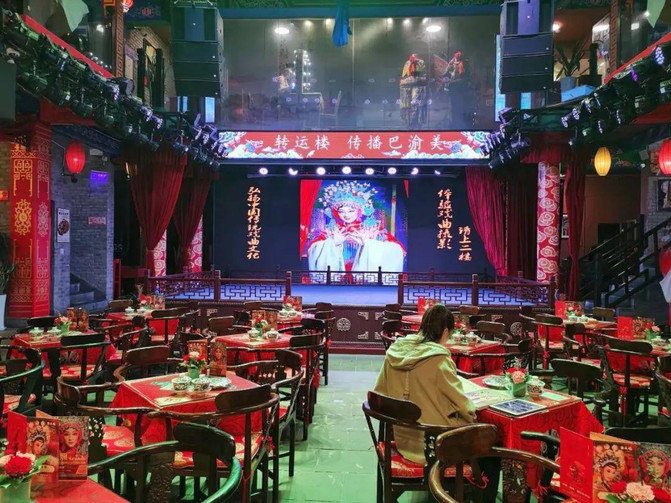
Opposite the transfer building is Zhongjiayuan, built in 1890. The owner is Mr. Zhong Yunting, who grew up in Ciqikou. He once served as a outsourcing contractor for the Empress Dowager Cixi, but later retired and returned to his hometown. He hired someone to design house drawings in Beijing and returned to Ciqikou to build the current Zhongjiayuan. The courtyard has the charm of a northern courtyard house, but the small green tiles and wooden frames used are very exquisite and elegant as southern folk houses. Today, Zhongjiayuan is a Citang with a porcelain exhibition hall. It mainly displays relevant figures, events and works during the heyday of porcelain production at Ciqikou, restoring the former prosperity of commerce and history of Ciqikou.

On the north side of Zhengjie is Baolun Temple. It was built during the Xianping period of Zong Zhenzong and Xianping. It has a long history and is one of the most famous Buddhist temples in Chongqing. It is said that Emperor Jianwen's seclusion in Ciqikou is in this temple, so it is also called "Longyin Temple". One of the magic things about Baolun Temple is that the main hall is supported by Masang wood that one person cannot hold together. No iron nail is used. The cornerstones of the double dragon plate columns on both sides are high and low. The high ones protrude out of the ground by a foot, and the low ones are recessed several inches, but they have not tilted for thousands of years.

In addition to the above historical courtyards and temples, Ciqikou is home to snack bars, clothing stores, specialty stores, and is an antique commercial street.

Walking around the streets, you will encounter interesting sculptures from time to time, reflecting the history and folk customs here.
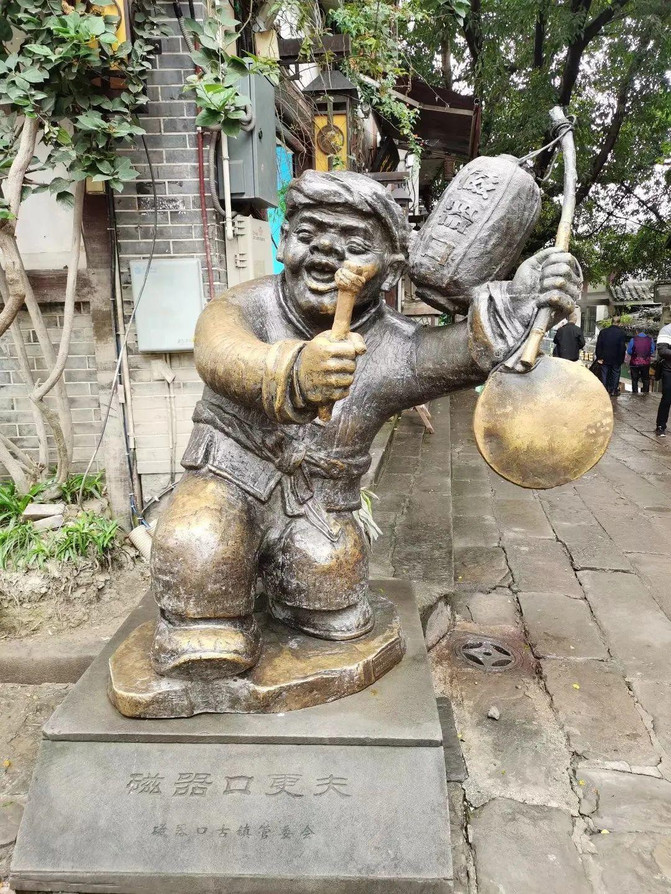
The sculpture of "Young Woman Urine Child" is located on the Hengjie of Ciqikou, not far from Baolun Temple. There is also a legend about sculpture: Emperor Jianwen, who was in trouble, suffered from asthma, strain, rheumatism and other diseases due to travel and fatigue. He did not dare to seek medical treatment because of Emperor Yongle's pursuit. One night, the immortal asked him in a dream and said,"A seven-year-old boy can pee." The next day when he went out to the temple to conduct an undercover visit, he found a woman holding a boy to pee. When he asked him, he was seven years old, so he explained his intention to ask for child urine. After drinking a bowl of boy urine, the pain was gone. This is the story of" Dragon Protection Water".

There is also a monument to those killed in the Anti-Japanese War in the ancient town. In 1937, Japan launched the "Lugou Bridge Incident" to invade China on a large scale. In December of the following year, Wang Jingwei, then vice president of the Kuomintang, betrayed his country and surrendered to the enemy, causing public outrage. In February 1940, the accompanying capital Chongqing established the "Chongqing Committee for Condemning Wang Ni's Crimes" with Feng Yuxiang as chairman. It mobilized donations from all walks of life to build a monument to the soldiers killed in the Anti-Japanese War, and sculpted a kneeling statue of Wang Ni in front of the monument.

During Japan's invasion of China, the Kuomintang also stepped up its persecution of revolutionaries. The Jazhizidong, three kilometers west of Ciqikou, is a prison where the Kuomintang military secretly imprisoned revolutionaries. The "Little Radish Head" we are all familiar with was once imprisoned here. Next, we will go to the Hongyan Scenic Area to experience the Hongyan spirit of the older generation of revolutionaries.

red Rock soul
Geleshan was originally a place with beautiful mountains and clear waters, but it seemed gloomy and cruel under the Kuomintang's white terror rule...
From 1939 to 1949, when the Kuomintang regime ruled the mainland, the Military Unification Bureau detained a large number of political prisoners fighting for freedom and democracy in secret prisons in Geleshan, among whom countless were killed. General Ye Ting, commander of the New Fourth Army who was detained during the "Southern Anhui Incident", was twice imprisoned here. General Zhang Xueliang, the initiator of the "Xi'an Incident", was also imprisoned here. Famous Communists Luo Shiwen, Che Yaoxian, Jiang Zhuyun, etc., as well as famous patriotic generals Yang Hucheng and Huang Xiansheng, sacrificed their lives here.

The Kuomintang has massacred political prisoners detained here many times, especially the massacres from September 6 to November 29, 1949. In the last month alone, about 300 people were slaughtered. Seven innocent children (including Little Radish Head) were not spared, and the youngest was under one year old. From the afternoon of November 27th to the early morning of November 28th, the massacres in Baigongguan and Zhizidong were extremely tragic. During the day and night, more than 200 lives were slaughtered, leaving mountains of corpses and seas of blood. It was horrific. This was the "January 27" massacre that shocked China and foreign countries.
On November 30, 1949, the People's Liberation Army entered the city, and Chongqing changed places. People collected the remains of the martyrs and buried them together in today's Geleshan Martyrs Cemetery. They also built monuments and sculpted grand group carvings to commemorate the achievements of the martyrs.
Not far north of the Martyrs Cemetery is Baigongguan, which was originally the villa of Sichuan warlord Bai Ju. Bai Ju claimed to be a descendant of Bai Juyi, a poet of the Tang Dynasty, so he borrowed Bai Juyi's name and named it "Xiangshan Villa".

In October 1939, Baigongguan was renamed Chongqing Temporary Detention Center by the Military Unification Bureau. In the "January 27" massacre, spies massacred detainees, killing nearly 30 people. Luo Guangbin (author of "Red Rock") and 19 others enlisted the help of guard Yang Qindian to escape from prison.

These revolutionaries have always had an optimistic revolutionary spirit in the difficult environment of the prison and firmly believed that Chongqing would be liberated. When Mao Zedong raised the national flag on Tiananmen Gate on October 1, 1949, they in prison made a national flag by imagination and hid it under the floor. They planned to carry it out of their cells on the day of Chongqing's liberation. However, the three martyrs Chen Ran, Liu Guozhen and Ding Diping died in the massacre. Only Luo Guangbin escaped danger. After the liberation of Chongqing, he returned to his cell. Take out this red flag.

It is the Hongyan spirit of the revolutionary martyrs of "tolerating adversity well and preferring difficulties not to be reckless" that has brought today's peace and paid tribute to countless ancestors who sacrificed their lives for the cause of justice!
jiefangbeiIn 1946, in order to commemorate the victory of the Anti-Japanese War, under the chairmanship of Zhang Dulun, then mayor of Chongqing, the foundation stone of the "Anti-Japanese War Victory Monument" was laid and started. After the founding of New China, the "Anti-Japanese War Victory Monument" was renamed the "People's Liberation Monument". Liu Bocheng, then chairman of the Southwest Military and Political Committee, inscribed the name of the "People's Liberation Monument". More than 40 years later, a commercial street centered on Jiefang Monument rose from the ground, making this commemorative landmark synonymous with Chongqing's prosperity.

Jiefangbei is Chongqing's city business card and the core of Chongqing's mother city. It is synonymous with the "city" in the eyes of Chongqing people and Chongqing in the eyes of foreigners. People often say that if you have not been to Jiefangbei, you have not been to Chongqing.
It includes comprehensive urban functions such as shopping, tourism, commerce, catering, entertainment, leisure and finance. It is the most prosperous, fashionable and desirable place in Chongqing and the "First Street in Western China".
In addition to the common shopping squares, brand stores, restaurants and other buildings on commercial streets, there are also trendy exhibitions and activities here. Stylish young people gather together to demonstrate the vitality and innovation of the city.

In addition to regular office buildings, there are also some heart-warming buildings that are refreshing. For example, the Guotai Art Center located on Linjiang Branch Road has a red pillar curtain wall with lush bamboo trees and forests. It looks like a burning bonfire from afar.

There is also the Chongqing Art Museum. The venue itself and the decoration on the square are full of artistic atmosphere.

The Liberation Monument is crowded during the day, and it is even more lively after night.
Tea houses, restaurants, singing halls and studios all lit up with colorful slogans, which were dazzling and eye-catching:

The bar is filled with carnival crowds, exuding passion and youth through spirits and music:

Street artists sing emotionally, decorating the night with flowing songs:
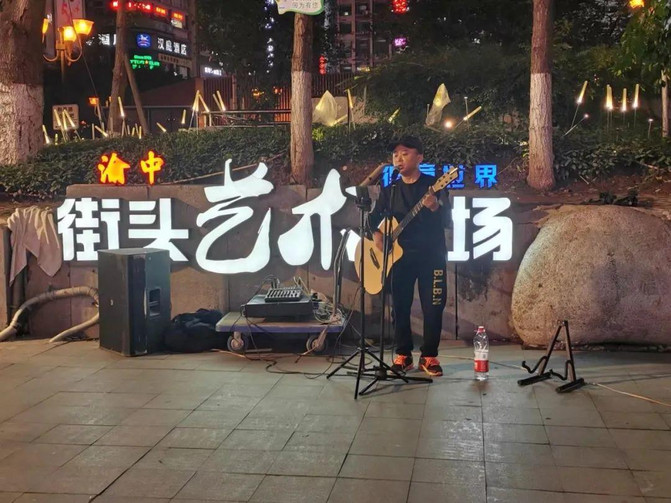
The beautiful sculptures are eye-catching and are the charm of the solidified music:

The rigid building during the day also looks charming under the light:

The "tall" Liberation Monument became more and more brilliant amidst the lights:

The pressing of ancient city gates and modern buildings, as well as the unique ups and downs of the mountain city, make the night more magical:


The most magical thing is Hongya Cave in the northwest of Jiefangbei and Chaotianmen in the northeast. Below, we take a boat sailing the two rivers at night to see the most beautiful night in Chongqing.

Tour the two rivers at night
Chongqing's night view was famous as early as the Qianlong period. Wang Erjian, then the magistrate of Baxian County, listed the night view of the mountain city as one of the twelve scenic spots in Bayu, so there is a saying that "You can't go to Chongqing without viewing the night view."
There are two highly regarded ways to see the night view of the mountain city. One is to cross the Yangtze River by taking the river cableway, and then climb the Nanshan Tree Observation Platform to overlook the colorful and charming night of the mountain city from high altitude and across the bank; Another is to take a cruise ship from Chaotianmen Wharf at the intersection of the Jialing River and the Yangtze River, go up the Yangtze River, and then turn back to the Jialing River. All the way through the Dongshuimen Yangtze River Bridge, Huguang Guild Hall, Ciyun Temple, Chongqing Grand Theater, Qianzaimen Jialing River Bridge, Nanbin Road, Hongyadong and other scenic spots, and finally return to Chaotianmen Wharf to enjoy the prosperous night scenery of Chongqing in all directions, multi-angles and up close range.

Chaotianmen, where the departure terminal is located, is itself the most distinctive landmark in Chongqing.

Chaotianmen was originally one of the seventeen ancient city gates in Chongqing. During the Southern Song Dynasty, the imperial court was peaceful in Lin 'an (present-day Hangzhou), and an imperial envoy sent imperial edict from the Yangtze River through the city gate, so the name "Chaotianmen" was given. What makes Chaotianmen stand out from many ancient city gates is not only its superior geographical location, but also several curved buildings built here. They are like giant ships sailing and giant bows ready to go, constituting the most shocking skyline in Chongqing.
(View the Chaotianmen Building from different angles)
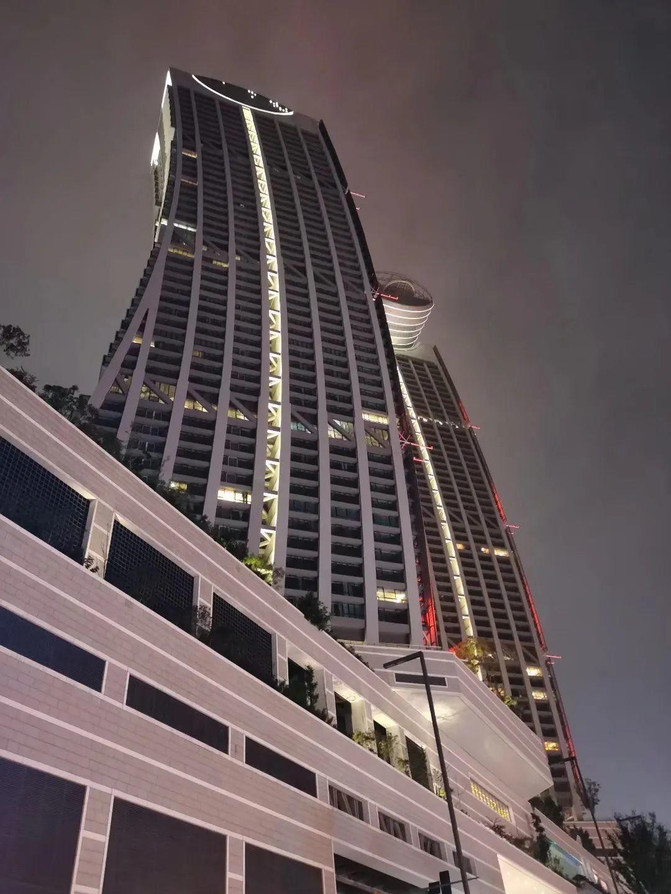


Above the Chaotianmen is Raffles Square, and the decoration at the entrance is eye-catching:


Withdraw our eyes from Chaotianmen and take the "Transportation Pearl" cruise ship at the dock, allowing us to start this fascinating night tour of the two rivers.

I have seen many night scenes, including the high-rise buildings in Pudong, Shanghai, the flowing sunset of the Haihe River in Tianjin, the Yanlong Cold Water in Qinhuai in Nanjing, and the Twin Towers of the Sun and Moon on the Four Lakes in Guilin... It is difficult to come up with new tricks when I think there is water. However, the night sky in Chongqing once again makes me feel a refreshing surprise. Perhaps it is the scattered heights of the mountain city that enrich the lighting levels, or perhaps the glorious bridges in the bridge capital that make the rivers and lakes bright...

Walking along the river, there are layers of lights on both sides. Thousands of lights and flashing neon lights embellished the night into a dreamy and bright place. The river water in different places presents different colors. Under the bright red bridge is the calm "Red Sea", and the dark blue cruise ship is The undulating blue waves, the colorful lights rippled and danced in the water, creating a discolored ribbon under the quiet and deep night sky.

The river is long, the river breeze is rustle, the moon is bright, and the clouds are visible. The bright lights on both sides of the river and the bright stars and stars in the night sky reflect in the water, as if swimming in the galaxy.

Today's river night glory is the "Qingming River Map" of the 21st century. It is a prosperous gathering of high-rise buildings, bridges, neon lights, luxury ships and technology. However, in ancient times before all these existed, the night scenery of the mountain city has become famous. This shows that Chongqing's mountains and rivers are themselves a good foundation. Wang Erjian wrote a poem praising the night view of the mountain city:
The houses in Yuzhou are high and low, and the houses in Shicheng are uneven.
Whoever fires thousands of torches will shoot a river back.
The waves are rolling and the light is difficult to hide, and the clouds flow and shadows are clear.
Looking at the endless meaning, the sky and water are crystal clear together.

The ancients called the night scene at the intersection of the two rivers the "Zi Shui Xiao Deng". It is said that the water flow at Chaotianmen twists and turns back and forth, naturally forming an ancient seal body similar to the character "Ba", hence the name "Zi Shui"; under the night, the lanterns are on at the beginning, and the waves shine brightly. This is the "night lantern". The "night lantern" reflects the "word water". The high and low cover each other. The light shines brightly on the river waves, and it interacts with the stars and stars, making it beautiful.

On the far shore of the cruise ship, the jade-like building is the Chongqing Grand Theater. The novel glass curtain wall constantly changes colors and words, expressing progress and blessings.



At the end of the night tour, we arrived at Hongya Cave. You can see the whole picture of Hongya Cave on the river. It is scattered in height and brightly lit, just like a magical soup house in "Spirited Away".

In fact, the building of Hongya Cave does not draw on animation inspiration, but is a row of ganlan-style hanging towers, which belongs to Bayu traditional buildings. Behind Hongya Cave are the tall buildings of Jiefang Monument. Ancient traditions and modern design complement each other, a kind of magical atmosphere arises spontaneously.

Let's go and find out what's inside the magical Hongya Cave.

hongya cave
Hongya Cave is located on Cangbai Road, Jiefangbei. It is the most distinctive landscape in Jiefangbei Commercial District and the most eye-catching landscape for night tours of the two rivers.

Hongya Cave has a history of 2300 years. As early as 316 BC, when the Qin Dynasty destroyed Ba, it was a military fortress. In the long years that followed, Hongya Cave successively formed Jiangai Fort, Zhanjiang Ancient Temple, Dongchuan Academy, Ming Dynasty City Wall, Tiancheng Street and other historical relics, leaving behind three major landscapes among the twelve scenic spots of Bayu and Chongqing, including the dripping green of Hongya, the sunset of Jialing, and the confluence of two rivers. It retains Bayu folk houses and hanging towers with unique mountain city characteristics. Culture. It is the only cultural landscape of the old mountain city left in Chongqing.

In the early years of the Ming Dynasty, Chongqing built seventeen city gates with "nine open and eight closed". The "Hongya Gate" here is a closed door with soldiers. People are accustomed to calling Hongya Gate "Hongya Cave", which is still in use today.

Red Cliff Drizzling is the landscape at the entrance of Jiabang Road on the first floor of Hongya Cave. There is a water curtain and stone paving under the city wall. Huang Tingjian, a world of the Northern Song Dynasty, once wrote a poem praising: "Iron flies high cliffs fall, green surges across the river." Wang Erjian of the Qing Dynasty also wrote an inscription: "Since then, the scenery on the immortal cliff is painted, and the blue light is a breeze."
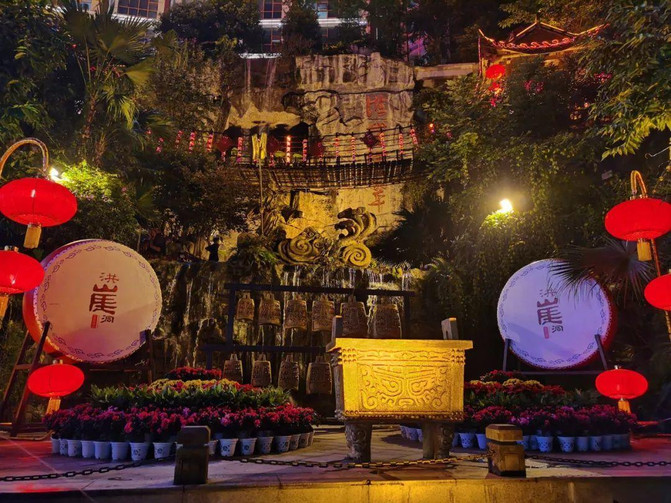
Nowadays, hidden in the encirclement of hot pot restaurants and hanging towers, the beauty of the "Cuiyong River" cannot be seen, but the dangers of the past can still be somewhat revealed-Jiabang Road is the entrance of Hongya Cave walking from Chaotianmen Gate. From the map, it is not far from Jiefang Monument. When walking to Jiefang Monument according to the navigation, it always "deviates from the route". Ask people and know that the first floor of Jiefang Monument and Hongya Cave are not at the same altitude at all, and you need to take the elevator to Cangbai Road on the 11th floor. It will only work if you use navigation again! It was indeed a mountain city, a mountain city that made navigation fail.

(You can admire the hanging tower of Hongya Cave from the side on the wooden bridge with green leaves on the Hongya Cliff)

(The Jialing River Bridge penetrates through the middle layer of Hongya Cave. Such a landscape is not uncommon in Chongqing, and there are also trains passing through the building)


Outside Hongya Cave at night, Jiabang Road is full of traffic and flowers. Tourists taking photos on the roadside are crowded with each other. In addition to tourists, there are also professional photography teams who can always capture the right angle in the narrow space and the traffic dragons in the river. The charm of Hongya Cave as a background is so attractive.

Hongya Cave is crowded with people, with rows of snack shops, specialty shops, etc. on both sides. Dining, entertainment, hotels and theaters cover everything. Each floor has its own characteristics. It is a three-dimensional air commercial street.


(Three-dimensional aerial pedestrian street)
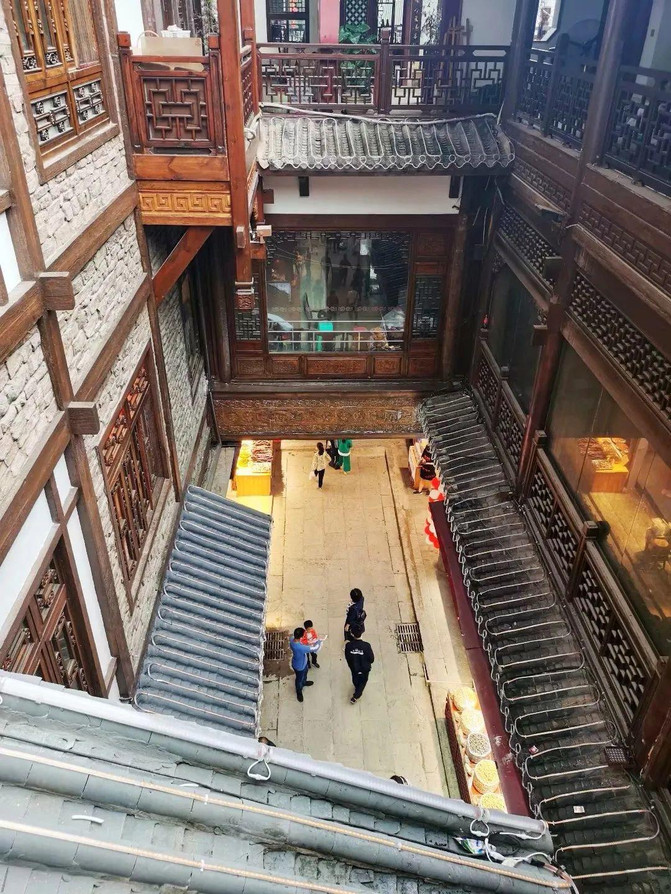
In the pedestrian street with up to 11 floors, there are many attractions such as Bayu folk customs, Baiye workshops, antiques, cultural creations, bars and singing halls, and second-yuan trendy toys. Among them, the most worth stopping is the "Reunion of Living Situations in the 1980s" on the fifth floor."and the light and shadow interactive space on the 6th floor of the" Twelve Scenes of Bayu ".
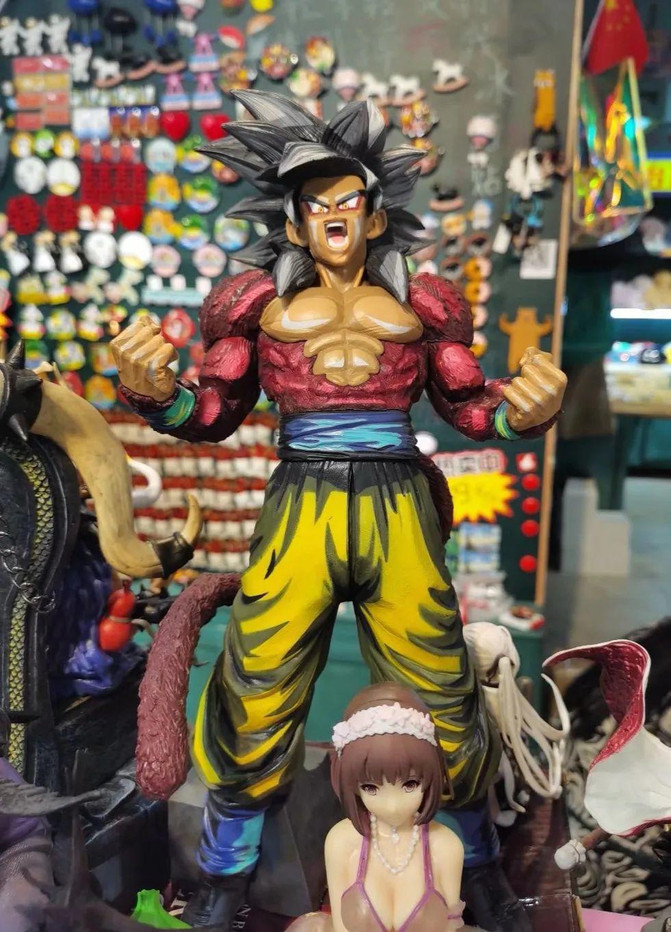
Sleepwalking of the Twelve Scenes of Bayu is through the interaction of light and shadow and changes according to solar terms. The transformation of the Twelve Scenes of Bayu from ancient times to the present is connected with stories and presented vividly and aesthetically, making people immersed in them and making them difficult to extricate themselves.

The twelve scenery are the beginning of spring·golden jade flowing fragrance, Jingzhe·Huangge Late Crossing, Qingming·song music Lingyin, grain rain·sea apple misty rain, summer·Tongjing Gorge ape, Xiaoman·cloud seal wind clear, summer solstice·Buddha Tu Night Rain, small summer heat·red cliffs dripping green, big summer heat·word water sky lamp, beginning of autumn·Longmen moon, white dew·Jinling clouds, heavy snow·Huaying snow, each scenery is a perfect blend of natural scenery and artistic processing, so beautiful.


Reunion in the 1980 block revolves around the scene culture of Chongqing's Laoxiang, truly restoring the market in the 1980s and 1990s. The film-level setting level allows people to travel through in one second, attracting countless young people to check in and take photos. Some born in the 1980s and 1990s can also feel a touch from it. In fact, it is not just Chongqing people, but foreigners will also feel something here, because some things of that era have been experienced by many cities.
Open-air billiards and canteen public phones should be childhood memories of many people:


The corner with the word "tear" written and the Hong Kong and Taiwan Star Pictorial posted seemed to be yesterday:


In an era when Internet cafes and bars were not yet popular, arcade and disco were entertainment venues for different ages:


What resonates with Chongqing locals may be scenes such as the No. 5 tram, Shancheng wide-screen cinema, Shancheng Photo Studio:


There are also real and virtual performances in the retro neighborhood. Artists play violin on the connected stage, and audiences can also watch 3D holographic images of Teresa Teng singing classic songs with the naked eye.


You can feel retro and nostalgic in the 1980 block, and you can also appreciate the down-to-earth and simple folk customs in the open-air sculptures of Hongya Cave.

Hot pot is the most popular food, and the butt of the fat baby who is in a hurry to eat has been patted brightly by tourists:

The sculpture below stands on the top floor of Hongya Cave and is 13.8 meters high. It is composed of green mountains, stone ladders, cliffs, old alleys and more than 20 suspended buildings. It is called "Memory Mountain City". It uniquely represents a city The alleys and characteristic landscapes of the historical mountain city are vividly displayed.

However, to have an in-depth understanding of the history and mountains and rivers of the mountain city, the Chongqing Museum must not be missed.
MuseumChongqing Museum is also known as the "Chongqing China Three Gorges Museum". The starting point of the Three Gorges is located in Baidi City in Fengjie County, Chongqing. The museum is located in Yuzhong District, opposite the People's Auditorium, an old landmark in Chongqing. Before entering the museum, we first went to see the People's Auditorium.

The People's Auditorium was built from 1951 to 1954 and was presided over by older revolutionaries such as Deng Xiaoping, Liu Bocheng, and He Long. It is majestic and resplendent. It combines the architectural style of traditional Chinese palaces with the long-span structure of Western architecture. It is Chongqing's top ten cultural symbols.

The main part of the auditorium imitates the plastic art of Tiananmen Square and the Temple of Heaven in Beijing. The north and south wings are equipped with long colonnade-like buildings. Green glazed tiles are posted on the roof, double eaves are flying, carved beams and painted buildings, pavilions are symmetrical and coordinated, and kissing animals have different shapes. The auditorium is the center for large-scale gatherings and performances in Chongqing City, and many Chinese and foreign leaders have left their footprints here.

On the square in front of the auditorium is the main entrance archway with a traditional ethnic architectural style. It has a unique shape, a harmonious layout, and is painted and carved.

Across the grand archway is the Chongqing Museum.
The Chongqing Museum integrates "Bayu Culture, Three Gorges Culture, Anti-Japanese War Culture in the Great Rear Area, Immigration Culture and United Front Culture" and displays ancient human specimens, Three Gorges Cultural Relics, Bayu bronzes, Han Dynasty Cultural Relics, Anti-Japanese Cultural Relics in the Great Rear Area, etc., which can provide a comprehensive understanding of Chongqing's past and present. Due to the limited space, I will select some important ones to introduce them to you.
The Wuyang Han Que on both sides of the stairs of the hall is one of the top ten treasures of the town halls. The appearance is a twin mother stone que on the top of the hall with double eaves. It is carved with living scenes, myths and legends, birds and beasts. It is the most completely preserved Han Que in my country.

The picture below shows the Three Gorges Waterfall Stone. It was cut from the edge of the Kimen Gate, which was called "a line in heaven and a gate in the gorge" in ancient times. It was washed by river water all year round. Because it is shaped like a waterfall, it is named Waterfall Stone.

Three Gorges trackers were people who used to make a living by pulling boats on the Xijiang River. Now they have disappeared. People can only see them in performances or photography and other works of art.

The Jingyun Stele in the picture below is also one of the treasures of the town hall. It was erected in memory of Jing Yun, the magistrate of Quren County in the Eastern Han Dynasty. The carvings on the stele are full of vitality, and the calligraphy is fresh and beautiful. It is a masterpiece among the Han steles.

The natural environment of the Three Gorges, surrounded by mountains and clouds and fog, has created the witch culture of the Ba people here. The Nuo opera performance widely circulated by the Tujia people is the continuation and inheritance of this ancient culture.

The Daliang rock paintings in Yunyang, Chongqing depict scenes of wizards 'practices in an intaglio manner. The painting style is simple and natural, full of primitive mystery.

The remnant of the left mandible of Wushan Man belongs to the Early Pleistocene 2.14 million years ago:

The tiger nux and the bird shaped zun are also treasures of the town hall. They are bronzes from the Warring States Period. The tiger of Hunuyu is related to the legend of the Ba people. The Ba people's ancestor, Jun Jun, turned into a white tiger after his death, so the white tiger was a totem worshipped by the ancient Ba people. Bird-shaped Zun was unearthed in the aristocratic cemetery of the Ba people. It is a rare artistic masterpiece for studying the Ba people's aesthetic taste and craftsmanship level.


On July 7, 1937, the Lugou Bridge Incident broke out, kicking off the prelude to the entire Chinese nation's War of Resistance. In November, the National Government moved to Chongqing. Immediately, from the Baishan Black Water to both sides of the Yellow River, from the Central Plains to the Suhang Sea, from the Jianghan Plain to the Lingnan Pearl River, tens of millions of compatriots and military and political institutions, industrial and mining enterprises, commerce, finance, universities, etc. moved to the rear area with Chongqing as the center. Chongqing rose from a commercial town to a wartime capital.
(The Japanese cherry blossom sword seized by Sichuan army general Guo Xunqi on the front line)

In order to destroy the Chinese people's will to resist war and cause huge strategic panic, from February 1938 to December 1944, the Japanese invaders concentrated aviation forces to carry out large-scale bombing of Chongqing and surrounding cities for more than six years. The Japanese military's strategic bombing was a kind of indiscriminate bombing, which carried out indiscriminate bombing on all areas including factory areas, commercial areas, cultural areas, residential areas, etc. The bombing time was long, the number of times, the means were cruel, and the disaster was severe. It is rare in the history of human warfare.
On June 5, 1941, Japanese bombers attacked Chongqing at night and bombed the residential area of Bichangkou in turn, causing the "Bichangkou Air Defense Tunnel Suffocation Massacre" that shocked China and foreign countries. The deaths and injuries were lost and the whole country was saddened.

After the victory of the Anti-Japanese War, the National Government returned to Nanjing, and Chongqing completed its sacred mission as the wartime capital. As a city of victory, Chongqing was awarded a permanent historical honor.

The museum also includes exhibitions on the history of the Ba people, Chongqing negotiations, and costumes of ethnic minorities in southwest China, so I won't introduce them one by one here. Let's go and visit Luohan Temple, which is the location of "Crazy Stone".

luohan temple
Luohan Temple is located on Chongqing Road not far from Jiefang Monument. It is hidden in the cracks of a high-rise building. It is a bit absurd. This is probably the reason why the absurd "Crazy Stone" was filmed here.
Luohan Temple was built during the Zhiping period of the Northern Song Dynasty (1064-1067). It was originally named Zhiping Temple. The temple was built for the Arhat Cave. There are more than 400 stone carvings of the ancient Buddha Cliff and the Northern Song Dynasty, and more than 500 clay sculpted arhat statues. It is the residence of the Buddhist Association of Chongqing City.

After entering the temple gate, you can see a square inlaid with bluestone, with the stone carving of Maitreya Buddha sitting in the center.

Behind Maitreya Buddha is an ancient Buddha Rock that is more than 20 meters long. More than 400 stone statues of Moyan in the Song Dynasty exist here. There are reclining Buddha, Guanyin statues and supporting figures, etc., and the style is close to Dazu Mountain stone carvings. There was an endless stream of people burning incense and worshiping Buddha here on the way into the temple.

Passing through the Ancient Buddha Rock, we arrived at the Daxiong Hall. There are many Buddhist art treasures in the hall, such as the statues of the Sixteen Honors, the 16 favorite students of Sakyamuni Buddha, the bronze statues of the "Three Saints of the West" of the Ming Dynasty, and the Buddha of Sakyamuni's becoming a Taoist Jade Buddha in Myanmar, copying the Indian mural "Painting of Sakyamuni Leaving the Palace and Being a Monk".

The most famous part of Luohan Temple is the Five Hundred Arhats Hall. Counting Luohan in Luohan Hall is a widely circulated traditional custom among the people. It is said that by counting Luohan, you can know your own good or bad fortune in those years.

There are four Buddhist halls in the entire temple, with a rectangular structure. The materials used are all wood and stone. The buildings are neat, beautiful in shape, and magnificent. The color paintings on the eaves columns of doors and windows are refined into birds, animals, flowers and scales, which are lifelike.

The entire temple and pavilions overlap, with deep halls, towering roofs, and flying eaves in the sky. It is set off by towering ancient cypresses and tall bamboo trees, making it very majestic and solemn.

At this point, the humanities and prosperity of the urban area are almost everywhere. Next, we will go to Houlping Township, Wulong, to appreciate the natural scenery of Tiankeng and Ground Gap.
tiankeng ground jointDriving about 170 kilometers southeast from Chongqing, we arrived at Wulong. This is a municipal district of Chongqing, but the city is not the protagonist here. Karst landscapes such as canyons, caves, underflows, and meadows are all over the area. There is the gorgeous Furong Cave here, which is filled with wonders such as giant curtain waterfalls and coral jade ponds formed by karst; there is the intoxicating and beautiful Furong River, with crystal clear water and strange peaks on both sides; here is the beautiful Fairy Mountain, the forest sea, strange peaks, pastures, and snowfields are magnificent and are known as the "Garden of Eden in the mortal world"; the most worth visiting are the magnificent Tiansheng Three Bridges (Tiankeng) and the beautiful Longshui Gorge Ground Gap.
(The pyramidal Wulong Visitor Center)

Tiansheng Third Bridge and Longshui Gorge are in the north and in the south. They are not far away. Let's go to Tiansheng Third Bridge first.

Tiansheng Third Bridge is located at the junction of Baiguo Township and Hetao Township, 20 kilometers southeast of Wulong District. Nature has created three giant bridges, Tianlong Bridge, Qinglong Bridge and Heilong Bridge, with an average height of more than 300 meters. It is the largest and tallest beaded Tiansheng Bridge group in the world. There are two sinkholes between the three stone arch bridges-Qinglong Tiankeng and Shenying Tiankeng. The three bridges sandwich two pits. The scale is grand, majestic and the scenery is magnificent!

If you have watched "Transformers 4", you will have an impression of a scene where Transformers are fighting in a valley on a robotic dinosaur. The scene of that scene is Wulong Tiankeng. Perhaps such a giant hole made in heaven is too huge for humans, and the city densely populated with high-rise buildings cannot be used by Cybertrans. The sinkhole is just suitable for giants to fight against each other.

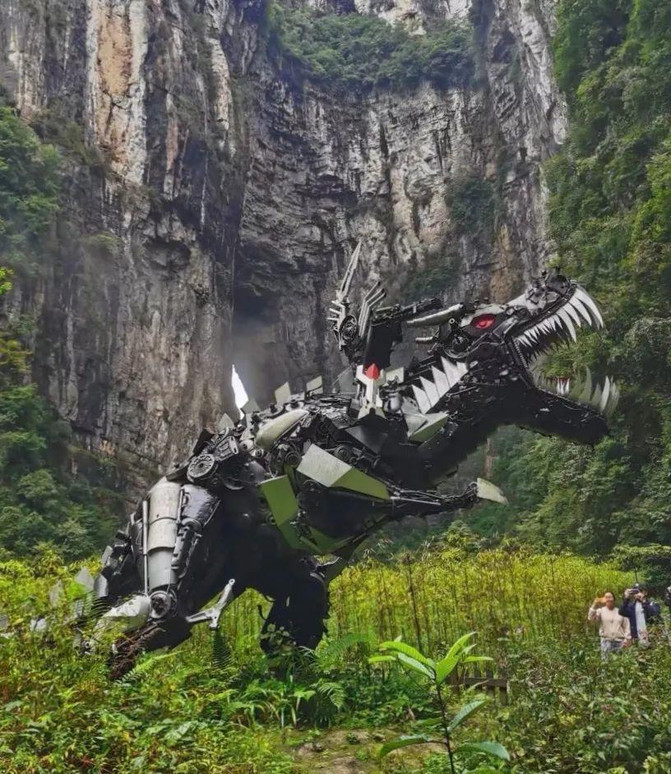
In addition to "Transformers","Three Lives of Peach Blossom" and "The City Is Full of Golden Armor" have also been filmed here, which shows that the three natural bridges are not only grand, but also very strange and beautiful, in line with people's imagination of fairyland and dangerous situations.

In "The City Is Full of Golden Armor", an assassin descends from the sky to chase down guests in Tianfu Official Posthouse. It was in this small courtyard hidden at the bottom of the mountain.

The roof of the official posthouse is covered by the vast abyss of Tianlong Bridge. The surrounding rocks are tall and the shrubs are green, giving a dark and sinister atmosphere.

Tianfu Guanyi existed in history. It was built in the second year of Wude of the Tang Dynasty (619). It is located at the key point between "Zuantianpu" and "Baiguopu". It was an important post for official information transmission in Fuzhou and Qianzhou in ancient times. It was later destroyed by the soldiers. The imitation courtyard we see today is at the lower end of Qinglong Bridge. There is a valley bottom avenue, about 5 meters wide. It is an antique post road where horses and horses can pass.

Looking at the sinkhole from different angles, it presents different shapes. Looking up at Tianfu Station, the overpass and mountain peaks are surrounded by a circle. It really seems that a hole has been opened in the sky.


When looking into the distance, some curves are soft like torches, and some are square like skylights. Perhaps the creations of Tiangong are not just casually waved, but carved with heart.


The most talked about is the bridge hole below the Qinglong Bridge. It is shaped like a large sword. There is a stream in front of the hole, and its reflection can be seen even more, just like Guan Gong's Qinglong Crescent Knife. There is only one knife handle in the scenic area and it is a popular place for taking photos.

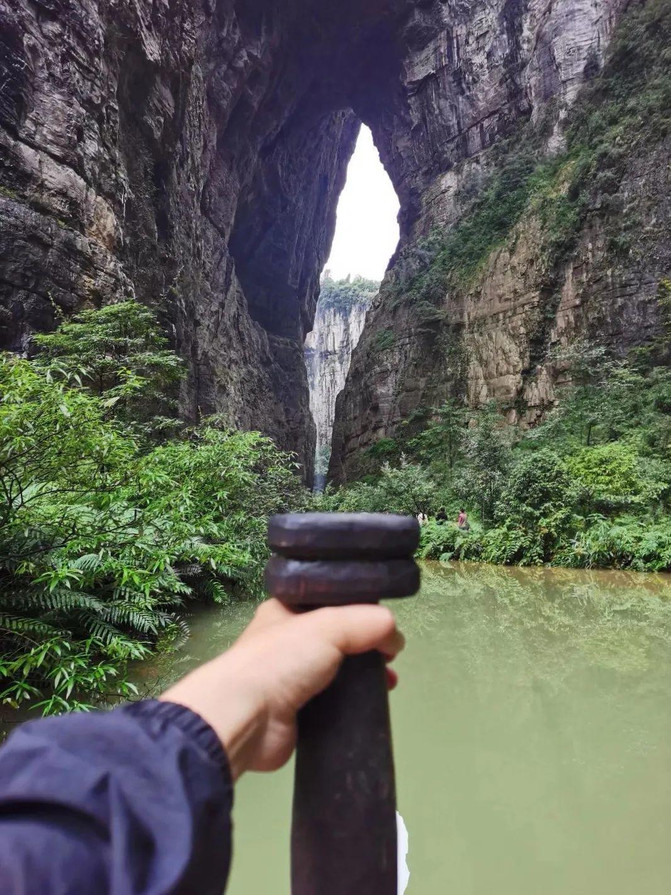
The sinkhole formed by Qinglong Bridge and surrounding stone cliffs resembles an eagle spreading its wings and ready to fly, hence the name "Shenying Tiankeng":

There are also many springs and waterfalls in Tiankeng. Some of them pour out from the top of the bridge, fly to rinse jade, and float in the wind, crystal clear. Some look like light smoke and mist and disappear when they enter the ground. Others rush out from the bridge wall, with three twists and turns, in a random manner.


The elevator from the entrance down to the tiankeng is also a major sight, vertically close to the cliff and majestic.

In addition, some naturally formed and artificially shaped sculptures are also impressive.
The picture below is called "Sacred Elephant Welcome": The protruding part of the stone wall below the North Bridge Hole of Tianlong Bridge resembles an elephant. It was eroded and cut by groundwater. It has stood here for millions of years, working tirelessly to welcome distant guests.

The picture below shows the "gorilla": a landscape above the stone wall of the Black Dragon Bridge. It has deep eye sockets and obvious facial contours. It is considered to be the patron saint of the Black Dragon Bridge.

There is a sculpture of a hermit playing chess under the Tianlong Bridge, which is leisurely and exciting:

This is the sinkhole, and then we will go to the ground seam for a journey to the core of the earth.

Passing through the long "tunnel of time and space"(above), I arrived at the bottom of the valley. I saw the gurgling stream in front of me, the green pool was deep, the valley walls were cut, the vines were winding, and the waterfalls flowed, making people feel dizzy and confused.

Looking up at the walls standing thousands of feet, the sky is shining, the fog fills the stream, and the deep cracks in the ground make people feel peaceful.


The mountain road is curved and embedded with green trees, and waterfalls gurgling down from the gaps in the trees. The green sound is pleasant to the ears and refreshing.


We undulating through the picturesque mountains and canyons and reached the lowest point of the ground seam.

The landscape here is called "a line of sky light": the height difference between the valley bottom and the valley top is 260 meters, and the narrowest part of the valley is 2-3 meters. Looking up at the valley bottom, you can only see a line of sky light, and looking down at the valley top, the valley is foggy. Deep and unfathomable, hence the name "ground seam".
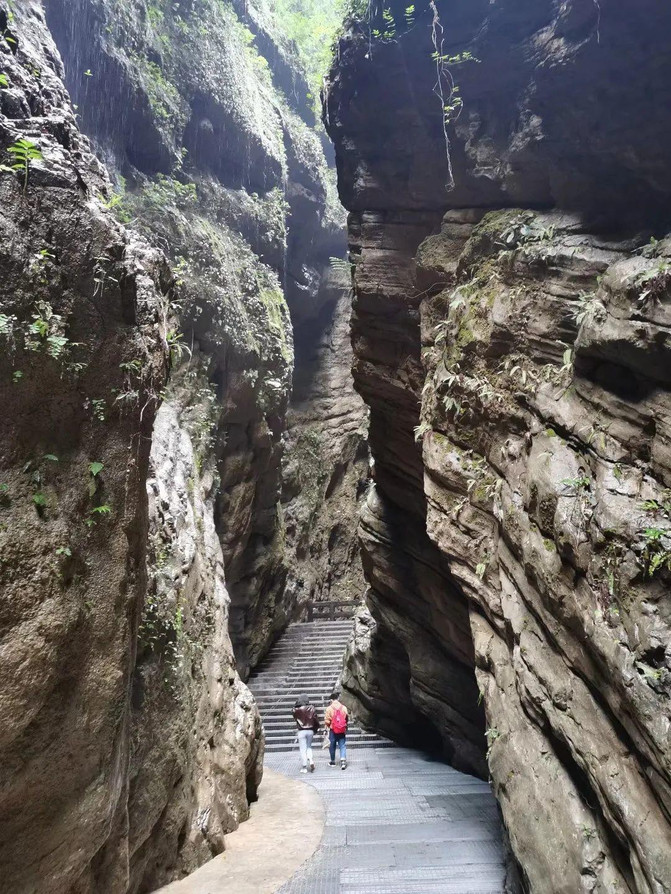

Walking further forward, a loud rumbling sound shook the deaf, and a white practice came into view not far ahead.

This magnificent waterfall is called the "Milky Way Flying Waterfall". This waterfall flows out of the mountain hole on the right wall of the canyon and erodes along the slope wall to form several deep pools of varying sizes, forming four step-like falls from top to bottom., the lowest level difference reaches 80 meters. A huge amount of water continues all year round, impacting on the hard rock on the left wall, eroding a huge pit and splashing many water. This process produces a large number of negative oxygen ions. Take a deep breath and feel refreshed, so here It is called "Natural Oxygen Bar".

The journey after the waterfall requires climbing up, and at the top of the stone ladder you reach Jiaolong Cold Cave.

Jiaolong Cold Cave is a huge dissolution cave with a height of nearly 100 meters. It was formed by early underground river water dissolved along rock cracks hundreds of millions of years ago.

This is also a downflow cave. Only the gurgling of water can be heard, but no running water can be seen. It is extremely quiet and chilly. It is said that a dragon cultivates here.

The milky stones in the cave are strange and eerie. They are masterpieces carved by hundreds of millions of years of running water.

Le is the city of fog
Chongqing people like to say "Le is the foggy city" when introducing their hometown, because Chongqing is foggy for more than 200 days a year.

The fog was misty.
Is this the reason why many suspense dramas love filming in Chongqing?
("The Silent Truth" was filmed in Chongqing. Such a bridge appeared in the beginning of the film. Under the bridge and the river are the body dumping sites)

Not exactly, I think.
In addition to Wudu, Chongqing is also the capital of Bridge, Jiangdu, Shancheng, and accompanying capital... Even in the impression of netizens, Chongqing is an 8D magic city.
(Bridge Capital: There are many bridges of different shapes)

(Mountain City: The buildings are scattered high and low, the picture shows Dongshuimen)

(Jiangcheng: The Jialing River and the Yangtze River pass through the city, and the cableway runs day and night)

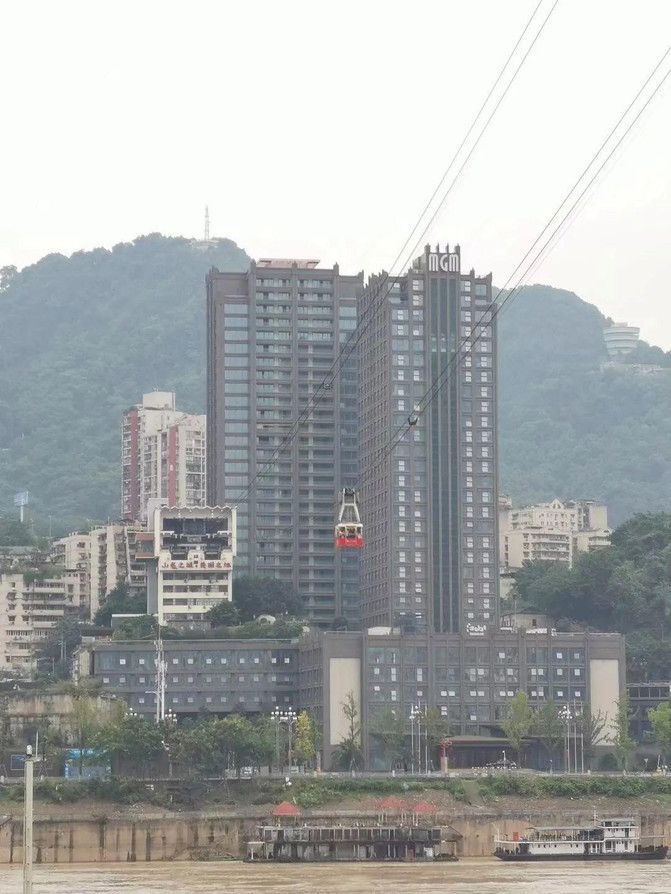
(8D Magic City: Traditional and modern coexistence, above-ground and underground transportation, a city that makes navigation difficult)


If this is not magic, then are the endless Crown escalator and the Liziba Light Rail passing through the building common in your reality?


One of the characteristics of suspense is uncertainty. You are not sure when the fog will clear. You are not sure whether you can climb the stairs or go through the alleys to reach your destination...
Uncertainty means rich possibilities: it turns out that a luxurious city can also be built on the mountain, and there are also Tiangong sinkholes and ghost axe crevices outside the city; it turns out that the narrow area is not necessarily messy, and the temples in the crevices are as strong as the incense; it turns out that the Jianghu is not all about noisy disputes, but also warm nights and grand aspirations of thousands of miles...
Le is the fog city.
It's not just the fog city.
Previous Article:Four days and three nights impression of Chongqing| Encounter the Charming Fog City and Magic Mountain City
